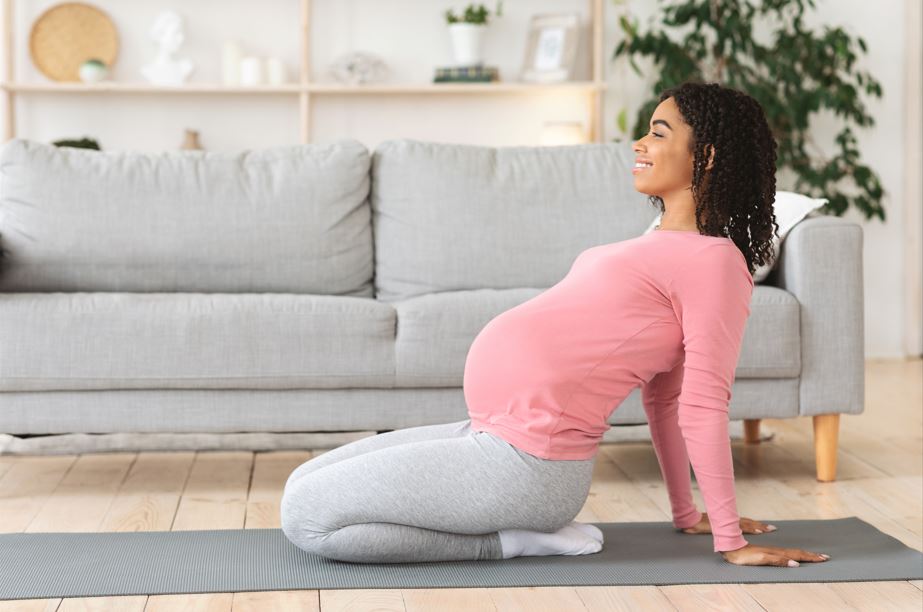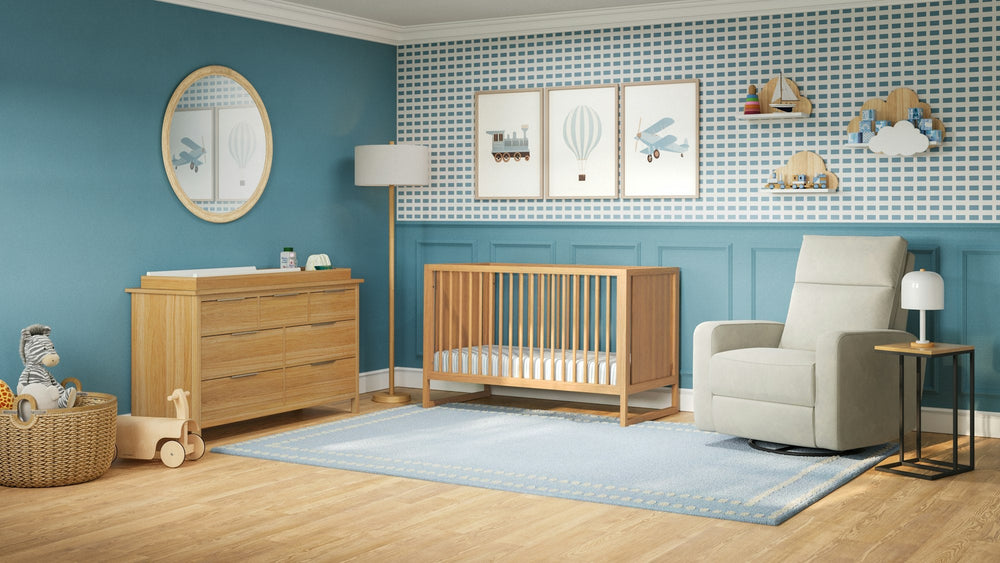
Regular exercise is a healthy habit at any stage in your life, including during your pregnancy. The Mayo Clinic recommends regular exercise while pregnant, even for those who weren’t working out pre-pregnancy.
However, if you are pregnant and wish to begin an exercise regime, it is recommended that you get your doctor’s approval before starting.
To help you begin, we’ve compiled a list of some of the best exercises for each trimester. Start small if working out is new to you, and remember to listen to your body and stay hydrated. So, if you’re ready, read on and let the prenatal workouts begin!
Is Exercising While Pregnant Safe?
If you are newly pregnant or thinking about becoming pregnant, you may be wondering about the safety of physical activity during pregnancy.
The good news is that the American College of Obstetricians and Gynecologists (ACOG) states that “women with uncomplicated pregnancies should be encouraged to engage in aerobic and strength-conditioning exercises before, during, and after pregnancy.”
Exercise is an essential aspect of a healthy lifestyle, both pre and post-pregnancy. In addition, the ACOG states that exercising while pregnant has many benefits for the mother- to-be and the baby.
As with all exercise routines, pregnant women should consult their health care provider before starting anything new, to assess potential risks. However, if you already engage in regular physical exercise, in most cases it is okay to continue the same routine once pregnant.
Aside from traditional cardio and strength training, some specific exercises and activities may help with back pain, strengthen your pelvic floor, and alleviate other bothersome pregnancy symptoms.
Working out while pregnant also boosts your mood, can help you sleep better, and reduces stress.
Some tips to keep in mind when working out while pregnant:
- Speak with your physician before beginning any type of physical activity.
- Stay hydrated.
- Wear supportive and breathable clothing.
- Avoid overheating.
- Take breaks when needed.
- Avoid laying on your back after the first trimester.
- Avoid hot yoga and contact sports.

First-Trimester Pregnancy Workouts
The first trimester is an excellent time to build up strength and endurance. With the onset of fatigue and morning sickness, it may feel impossible to fit in any physical activity. But, adding some quick and easy exercises to your daily routine will reap enormous benefits for your overall well-being and lower body strength essential to supporting your growing baby.
If you exercise regularly and have gotten the sign-off from your physician, there’s no reason to stop what you’re doing! If you have not been engaging in pre pregnancy workouts but would like to start with some simple, low-impact, activities, here is a list of safe exercises to add to your first-trimester workout plan.
Squats
Love them or hate them, squats are an excellent lower body exercise. They improve your glutes, hamstrings, and quads.
To perform squats, stand in front of your couch or a chair with your feet slightly wider than hip-width apart. Activate your hips by tilting your pelvis slightly back, then bend your knees and start to lower your body as if you are going to sit down. Right before your bottom touches the chair, slowly stand back up.
Start with three sets of 10.
Pelvic Curl
The pelvic curl is a basic Pilates exercise that strengthens your spine. Start by laying on your back with your knees bent and your feet flat on the floor hip-width apart. Then, take a deep, slow breath and tuck your pelvis downward. Exhale as you lift your spine slowly off the ground, keeping it in a straight line. Your shoulders should remain resting on the mat. To finish, slowly lower your hips and pelvis back to the ground.
Repeat three to five times.

Single-Arm Arrow and Tricep Kickback
The single-arm arrow and tricep kickback is an exercise that isolates and works the tricep muscle on the back of the arm. If you don’t have dumbbells, you can use water bottles or cans of soup.
To begin, step your left foot forward and slightly bend your left knee. Rest your left hand on your left thigh. If you need additional support, you can lean on an exercise bench or chair. Hold a dumbbell in your right hand. Starting with your arm in a bent position, straighten your right arm out behind you, slowly and with control. Then, with the same controlled movement, bring your arm back to the starting position.
Do three sets of ten per arm.
Side Plank Crunch
Planks strengthen your abdominal muscles. The side plank focuses on your obliques and shoulders. Lie on one side by propping yourself up using your hand and forearm. Stack your legs and extend them out straight. Next, push yourself up by raising your hips and side off the ground and reach your upper arm over your head. Simultaneously bend your top knee towards your center as you bring your elbow down to meet it.
Side plank crunches are not a beginner fitness level exercise, so if this is challenging, try simply holding a side plank on each side for as long as you can. Then, once you have built up some strength, you can try a few reps on each side.
Bicep Curls
Bicep curls are an upper body exercise to prep your arms for holding and carrying around your new baby while sculpting your arms simultaneously!
Stand with your feet slightly wider than your hips, and your knees slightly bent. Hold a dumbbell in each hand. Slowly bend your elbows while raising the dumbbells to your shoulders. Hold for a few seconds, then with control, lower them back down.
Try three sets of ten per arm.

Running
If you are already a runner, there is no reason to stop unless advised otherwise by your doctor. However, it is important to listen to your body and to include a warm-up and a cool down with each session. As your body weight increases during your pregnancy, you may find running difficult. If that’s the case, consider modifying your workout routine to include walking.
Walking
Walking is an ideal pregnancy workout. It is low-impact, easy to do, and requires no equipment other than a comfortable pair of shoes. In addition, walking while pregnant can reduce backaches, constipation, keep your weight gain in check, and is an excellent cardio workout.
Yoga & Pilates
Yoga is another low-impact exercise that should be a part of every pregnant woman’s exercise program. Yoga can ease tension on the lower back and works all of the muscle groups.
Prenatal Pilates is another excellent way to strengthen and stretch your muscles. Classes for both are easy to find as many gyms and health clubs offer specific prenatal classes.
Second-Trimester Pregnancy Workouts
At the start of your second trimester, you may feel your energy coming back. If you haven’t already started an exercise routine, now is the time to start! During your second trimester, you should avoid HIIT, running, and other high-impact exercises.
Incline Pushups
Pushups are excellent for building chest and shoulder strength.
Using a ledge, railing, or bench, place your hands shoulder-width apart. Then, slowly lower yourself while bending your elbows and bringing your forehead towards the ledge or railing. Keep your body in a V alignment.
Do two sets of twelve reps.
Curl and Press
Hold a pair of dumbbells and stand with your feet hip-width apart. Engage your core and keep your chest tall, allowing your arms to rest gently at your sides. Slowly curl the dumbbells up to your shoulders. Then pivot your arms out and up as you press the dumbbells above your head. Reverse the movement and repeat.
Complete three sets of ten to twelve reps.
Hip Flexor and Quadriceps Stretch
We often ignore our hips when working out, but tight hips can affect mobility and cause back pain. In addition, strong hips are critical to a fit pregnancy for carrying extra baby weight and during labor.
Start in a half-kneeling position with your right knee on the floor and your left one in front of you. Stretch your right hip and thigh by lunging toward your left foot and pulling your right foot back up towards your glutes. Hold the stretch for about ten seconds. Switch sides and repeat.

Bent-Over Fly
Bent-over flies are another excellent exercise for shoulder strength. Shoulder strength contributes to the building of core muscles which may help prevent diastasis recti postpartum. Diastasis recti is the separation of the abdominal muscles that about 60% of women will experience.
To do a bent-over fly, bend your knees while holding two dumbbells with palms facing each other. Next, slightly lean forward while keeping your back straight and raise both arms to the sides, then slowly lower them back down.
Do three sets of ten to twelve reps.
Side-Lying Leg Lifts
Side-lying leg lifts are a barre exercise that targets your abdominal muscles. Lie on your right side and bend your bottom knee with your other leg stacked on top. Create a small gap between you and the ground by lifting your side up and slightly angle your left leg in front of your body. Then slowly raise your leg off the ground.
Do two to three sets of ten to twelve reps each on each side.
Walking
Walking is a safe and recommended pregnancy exercise during all three trimesters. Walking is the best exercise to prevent blood clots, a condition pregnant women are more prone to, and it can also keep your blood sugar levels in check, which may decrease your risk of gestational diabetes.
Yoga
Yoga is another beneficial exercise you can partake in each trimester. Prenatal yoga prepares you for giving birth by working on breathing exercises and stretching, and building muscle. Pregnant women should avoid hot yoga classes and be mindful of their balance to prevent falls. Look for workout videos or in-person classes specifically tailored for pregnancy.
Third-trimester pregnancy workouts
Your third trimester will make exercising more difficult due to your size and physical stamina. However, if you feel comfortable, carry on doing the exercises you’re already performing!
If you haven’t started, it’s still not too late to initiate a routine physical regime even if you haven’t exercised in the previous two trimesters.
The best pregnancy workouts for your third trimester focus on cardio and maintaining your physical strength.
Swimming
Once you’ve reached the final trimester, your body likely feels alien to you. You may have back pain, swollen ankles, and just feel heavy in general. Swimming is a great activity to engage in, even recreationally, to take some of the weight off your feet and to help you relax. Water aerobics is another low-impact way to get your heart rate up.

Ellipticals & Stair Climbers
The key for the third trimester is low-impact activities that maintain your cardiovascular strength. While there is no single cause of preeclampsia, a dangerous condition for mother and baby caused by a spike in high blood pressure, obesity, diabetes, and a history of high blood pressure are related risk factors.
Ellipticals and stair climbers are low-impact options you can do at your own pace to maintain cardiovascular health.
Dance & Aerobics Classes
Barre, low-impact dance, or aerobics classes are fun cardio activities. If you’re worried about what you’ll look like or prefer to exercise at home, check out fitness apps and online videos for some pregnancy-specific dance workouts.
Walking
If everything else seems too daunting or exhausting, then stick with walking! Walking is beneficial at all levels and amounts. Aim for twenty to thirty minutes a day for optimal benefits.
Yoga
Continue engaging in prenatal yoga, stretching, and breathing exercises. Expecting mothers can perform many breathing techniques used in yoga during labor to decrease pain and relieve stress. In addition, regular yoga practice improves blood flow providing your baby with the oxygen-rich blood it needs to develop.
No matter what stage of your pregnancy journey you are in, it is never too late to incorporate physical activity. When exercising while pregnant, listen to your body and rest when needed. Pack a snack for long walks or trips to the gym, and always stay hydrated.
If you’ve never worked out before, ask your physician for recommendations and look for prenatal classes at gyms and sports clubs. Regular physical exercise is one of the most beneficial things you can do, not only for yourself but also for your growing baby!








